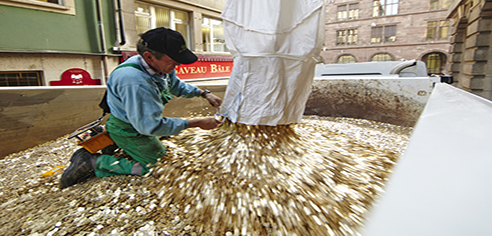
Gold price: ETF inflows reach $100m a day


In dollar terms net inflows in January equaled $3.1B with the value of gold held in ETF vaults reaching just shy of $107B by the end of the month, a 6% increase.
January was the fourth consecutive month of net inflows, according to WGC data and thanks to a blockbuster December 2018, 185 tonnes or $8B was injected into the scores of funds listed around the world over the past four months.
The industry body says the inflows were driven by market uncertainty and a shift in sentiment that drove the price of gold 3.5% higher in January.
Fund flows strongly reversed the Q3 2018 declines with total inflows of 9% over the past four months.
North American gold investors led the buying with funds in the region, enjoying 53 tonnes or $2.2B of net inflows.
Low-cost ETFs, defined by the WGC as funds that charge less than 2% management fees, are becoming particularly popular adding 16 tonnes (worth roughly $700m) over the past six months, representing growth of 53%.
WGC notes that global gold trading volumes increased in January on par with 2018 averages. More than $112.5B of gold was traded on average each day in 2018 in over-the-counter transactions, futures exchanges and ETFs.
That compares to trading volumes of $23B in Dow Jones stocks and not far behind all the shares traded as part of the S&P 500 index ($124.7B).
Sentiment and positioning in Comex futures in New York is unclear as there has not been an update to positioning by large-scale speculators such as hedge funds since mid-December; a consequence of the US government shutdown.
The WGC says it believes “net longs increased yet remain below historical averages.“
A recent study by the WGC showed bearish positioning in futures historically precedes strong rallies in the price of gold.
Gold closed at $1,314.40 an ounce on the Comex market in New York on Wednesday, down on the day but up more than $130 an ounce from its summer lows.


Trump weighs using $2 billion in CHIPS Act funding for critical minerals

Codelco cuts 2025 copper forecast after El Teniente mine collapse

Electra converts debt, launches $30M raise to jumpstart stalled cobalt refinery

Barrick’s Reko Diq in line for $410M ADB backing

Abcourt readies Sleeping Giant mill to pour first gold since 2014

Nevada army depot to serve as base for first US strategic minerals stockpile

SQM boosts lithium supply plans as prices flick higher

Viridis unveils 200Mt initial reserve for Brazil rare earth project

Tailings could meet much of US critical mineral demand – study

Kyrgyzstan kicks off underground gold mining at Kumtor

Kyrgyzstan kicks off underground gold mining at Kumtor

KoBold Metals granted lithium exploration rights in Congo

Freeport Indonesia to wrap up Gresik plant repairs by early September

Energy Fuels soars on Vulcan Elements partnership

Northern Dynasty sticks to proposal in battle to lift Pebble mine veto

Giustra-backed mining firm teams up with informal miners in Colombia

Critical Metals signs agreement to supply rare earth to US government-funded facility

China extends rare earth controls to imported material

Galan Lithium proceeds with $13M financing for Argentina project

Kyrgyzstan kicks off underground gold mining at Kumtor

Freeport Indonesia to wrap up Gresik plant repairs by early September

Energy Fuels soars on Vulcan Elements partnership

Northern Dynasty sticks to proposal in battle to lift Pebble mine veto

Giustra-backed mining firm teams up with informal miners in Colombia

Critical Metals signs agreement to supply rare earth to US government-funded facility

China extends rare earth controls to imported material

Galan Lithium proceeds with $13M financing for Argentina project

Silver price touches $39 as market weighs rate cut outlook


















